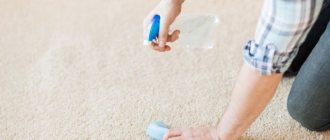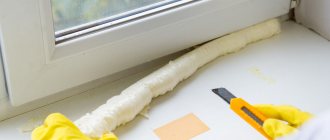Polyurethane foam is widely used in construction and repair work as a sealant, adhesive, and heat insulator. When using it, it is advisable to cover the surfaces to protect them from contamination: film, oilcloth. But how can you wipe off the mounting foam from linoleum if the stain does get in and “grab” onto the surface? There are several methods and many means, both specially created for cleaning (professional) and folk ones, to correct the situation, without knowing which you can only aggravate the problem.
How to clean fresh?
In the case where the foam has just hit the floor, it can be removed quickly and without consequences. At first, a piece of polyurethane foam is so light that you can accidentally smear it by catching it with your hand or tool.
The best option is to wait a little. When the sealant begins to harden, it will no longer actively stick to hands and objects. At this stage it will become practically rubber, and you can remove it by picking it up from the edges.
If you don’t have time to wait, you can try to remove the foam ball even when the sealant is still sticky and movable. You will need white thick sheets and silicone cream or oil.
Procedure:
Lubricate the linoleum around the polyurethane loose ball with silicone compound.- Take one sheet of paper and rub it along the edge with silicone oil (cream).
- Using the treated side of the sheet as a spatula, you should try to pry off the foam and move it onto the sheet. With a second sheet of paper you need to help yourself move the ball and prevent it from moving further along the linoleum.
- After the sealant is removed, it is advisable to wipe the linoleum in the area of treatment with wax or linseed oil.
If the polyurethane foam on the floor is not smeared and has a compact shape, it will not be difficult to remove it. The final result will largely depend on how tightly the sheet used to remove the foam was pressed to the floor surface. The denser it is, the better the cleansing will be done.
When removing uncured foam, you need to move from the edges to the center of the contamination to avoid spreading the sealant over a large area.
Basic rules: how to remove polyurethane foam from linoleum
To remove this type of pollution, you often don’t need to put in a lot of effort or spend a lot of free time, you just need to choose an effective product.
But without taking into account the generally accepted rules that guide all experienced craftsmen, the list looks like this:
- Since the material strongly adheres to the surface of the coating, you need to be as careful as possible and not use excessive force when trying to scrape off the stain with a handy tool.
- The softened layer is not always easier to remove from the surface; in some situations it is best to let the dirt harden completely.
- If you have no experience in using reagents, you should first read the instructions for use.
- When performing manipulations, it is worth protecting the skin of your hands; ordinary rubberized gloves will do.
The process can be safely called delicate; there is no need to rush, otherwise eliminating errors will lead to replacing the damaged area. And if a piece of material of a suitable shade or pattern is not found, then the entire perimeter of the room will need to be re-covered with a new piece.
How to remove dried ones using improvised means?
To scrub polyurethane foam, not only purchased special preparations can be used, but also those products that are already in the household. First, remove the bulk of the polyurethane . This can be done with a stationery knife.
In this case, it is necessary to cut off as much foam as possible. And only after removing the main lump do they move on to using chemicals.
You need to cut off the hardened foam as carefully as possible so as not to scratch the linoleum.
Dimexide
One of the most common home remedies for traces of polyurethane foam is the external pharmaceutical drug Dimexide. Its advantages are efficiency, availability and low cost.
Use it straight from the bottle:
- applied to the area requiring treatment and distributed with a napkin or brush;
- leave for a couple of minutes;
- wash with a rag, prying up the softened mass with a plastic or wooden scraper;
- wash the floor with hot water and detergent.
Dimexide should only be used with gloves. Due to its high penetrating power, this product can damage the skin of your hands.
Method of application - in the video:
Vinegar
It is not possible to remove foam from the floor with vinegar in all cases . For hardened, heavily smeared sealant, this option is ineffective. Even using a plastic spatula, removing stains with vinegar will be difficult and time-consuming.
If during the initial treatment there is no result from using vinegar, it is better to move on to other methods, since overdoing it can damage the linoleum.
Vegetable oil
Vegetable oil, especially heated oil, has the ability to soften foam and facilitate the process of washing it off. To make scrubbing the stain easier, the procedure should be as follows:
- The oil needs to be heated.
- Apply and distribute.
- Leave for 15-20 minutes to act.
- Using the hard side of the sponge and a plastic scraper, scrub off the foam.
- After completion of the work, excess oil must be removed so that the linoleum does not remain slippery.
Vegetable oil is the most affordable, harmless and simple means for washing polyurethane foam from linoleum.
Vegetable oil
Vegetable oil can remove both fresh and dried foam. Especially if you warm it up (things will go faster).
Application to the surface is carried out using a paint brush:
- The oil should be evenly distributed.
- After this, wait approximately 20 minutes.
- Then the foam is scrubbed off using a hard sponge, a plastic spatula and other available means.
- Any oil remaining on the floor is removed with a paper towel.
- Then wipe the cleaned area with a damp cloth.
This method of removing dried foam is simple and accessible and does not require any costs. After all, vegetable oil is found in every home.
Vinegar
Using vinegar is not the most suitable option for cleaning linoleum from polyurethane foam, but you can try it. Vinegar can soften a stain that is not too old. But at the same time, the sealant should not be heavily smeared on the floor.
You should not use concentrated vinegar essence, it can ruin the flooring. You can try scrubbing the polyurethane foam with regular table vinegar. Acid can soften the foam. If this method is unsuccessful, try other options.
Top 3 special drugs
Special products can be used to dissolve and remove drips and traces of polyurethane foam. Those designed for washing mounting guns are suitable.
Ultima professional
The cleaner is available in cylinders with a universal adapter . The product is intended for removing unhardened foam from various types of surfaces. The product is also suitable for cleaning linoleum - removing a sticky thin layer from the floor. Packaging volume – 500 ml. Price – from 200 rubles.
PENOSIL Foam Cleaner
The cleanser is designed to remove uncured foam from tools and dirty surfaces. The drug does not require exposure to a dirty surface, as it acts almost immediately. Cost – from 150 rubles per 500 ml. Read reviews here.
Penosil Cured PU-Foam Remover
The solvent is an effective cleaning product for removing already hardened foam. The product is distributed over the stained area and removed after the polyurethane has softened. The cost of a can is from 300 rubles.
Variety of works and methods of surface protection
The foam is very sticky and sticks tightly to surfaces.
The use of polyurethane foam in modern construction is very popular due to the many positive qualities of this material.
The need to create a moisture- or air-tight layer, to fill gaps or cracks forces craftsmen to resort to the use of polyurethane foam, which perfectly copes with the task when:
- sealing seams and joints;
- filling voids;
- creating thermal insulation;
- used as a sealant.
There are situations when a foaming composition is used for gluing various materials. Due to the popularity of foam made for installation work, it is widely used by both professional builders and those who do repairs themselves without seeking help from specialists.
There are certain rules that must be followed when working. They will help to avoid unforeseen situations and contact with various surfaces.
Freshly sprayed foam should be removed as quickly as possible with a rubber spatula.
Adhesion is reduced, and the low level of adhesion to other materials allows you to quickly and easily get rid of the stain.
A rubber spatula will help you do the job carefully and accurately. You can also use a wooden tool; it is undesirable to use metal devices, which can easily damage the surface, compromising its integrity.
Related article: Lemon-colored wallpaper in the interior of different rooms
In addition, it is impossible to increase the size of the spot, which means that all movements must be directed from its edge to the center. As if when collecting it, you will have to use one spatula to try to give the stain a minimum size and transfer the substance to the second spatula.
A rubber tool is used as a scraper, and a wooden one plays the role of a kind of shovel or scoop into which foam is transferred from the floor surface.
Quickly assembling a team is not enough. There are traces left on the linoleum that must be removed immediately so that there are no traces or cloudy stains left on the finishing decorative layer that stand out under the light of the sun's rays. After removing all the composition, you need to wipe the damaged area of the coating with a special product, then apply wax or flax oil to it.
Ideally, to remove the stain, you need to use a special solvent created to get rid of the installation that has not yet hardened.
Among these compositions, the following are especially popular:
- PENOSIL;
- Foam Cleaner;
- Oppa;
- UltimaProfessional.
Recommendations from experts
When washing linoleum from foam, you must follow the advice of professionals:
When planning work with polyurethane foam, it is better to wipe the linoleum in advance with powdered laundry soap or linseed oil.
This will prevent the foam mass that accidentally falls down from firmly grasping the floor covering.- If it is not possible to polish the floor before using foam, it can be covered.
- Washing with acetone can give results, but such treatment can lead to the formation of dull spots on the surface.
- Before using a product to remove marks left by fallen foam sealant, it must first be tested on an inconspicuous area.
- The removal of foam should be completed by treating the surface with linseed oil or wax. This will add shine to the area and make foam marks less noticeable.
- When choosing special foam removal products, you need to pay attention to what specific composition they are intended for - fresh or hardened sealant. This will allow you to use the professional product as efficiently as possible.
- When processing linoleum, it is recommended to take into account its type - homogeneous (single-layer) or heterogeneous (multilayer). For the latter option, the use of acetone is strictly prohibited; for the first, it can be used to a limited extent, and only in extreme cases.
- Special products are applied to the stained area and left for several minutes. As soon as the foam begins to soften, you need to start cleaning it off.
- If possible, it is advisable to choose a polyurethane foam cleaner from the same company as the polyurethane sealant itself.
- Many cleaners emit toxic fumes, so remove polyurethane foam residues with good ventilation.
- Increased haste when removing polyurethane can lead to damage to the base of the material.
- If there are scraps of linoleum left after laying the floor, it is convenient to check the effect of the cleaners on them.
- The use of solvents must be combined with scraping.
You will find useful tips and recommendations on how to remove polyurethane foam from various surfaces and objects here.
What you should absolutely not do
In the process of cleaning any floor covering from fresh or hardened construction foam, in no case should you use acetone or other liquids containing it in their composition. This is due to the fact that after treating linoleum, parquet or laminate with acetone, a purple stain may remain on their surface, which cannot be removed with anything.
It is also not recommended to scrape off frozen foam with a knife or other sharp objects, since it will not be possible to remove scratches from the floor covering after the work is completed.
The process of cleaning polyurethane foam from the floor surface is quite simple if you are careful and attentive during this work. But besides this, the result of such work often depends on the area of contamination and the quality of the floor covering. Therefore, in order to protect the floor surface from such contamination, before using polyurethane foam it is necessary to cover the floor with film, newspaper or a large piece of material.
Pros and cons of using
Today, almost every home has PVC windows installed or plans to install them. During the installation process, polyurethane foam will definitely be used, since it is a reliable sealant.
Its unique ability to penetrate even the tiniest cracks, the ability to seal seams and glue parts are the main advantages of the material. At the same time, it has moisture-, heat- and sound-proofing properties.
Despite the many advantages of this material, it has a small drawback, which is the difficulty of laundering. If the sealant gets on surrounding objects during work, then it is quite difficult to correct the situation. Many people wonder how to remove polyurethane foam. There are various effective ways. The choice of method should be based on the coating material.
Precautionary measures
Foam is a substance with a high degree of adhesion. This means that the foam molecules penetrate deeply into the material and bind tightly to it.
Polyurethane foam is used to blow in cracks when installing doors
While installing the door structure and blowing in cracks, stick a protective film on those areas where the product can get in. This is better than then standing for hours and trying to wash off the frozen mass.
Protective film is not a 100% guarantee of cleanliness. Droplets can still get into some places, and even those who have been working with the installation substance for many years are not immune from this.
Sources
- https://VseoDveri.ru/montazh/chem-otteret-montazhnuyu-penu-s-dveri-sposoby/
- https://wizard-aerosol.com/germetiki/chem-otmyt-montazhnuyu-penu-s-lyuboy-poverhnosti-10-sposobov.html
- https://DomZnatok.ru/uborka/sovety/kak-otteret-montazhnuyu-penu/
- https://DecorObot.ru/stirka/chem-otmyt-montazhnuyu-penu.html
- https://poleznii-site.ru/dom/byt/kak-otteret-montazhnuyu-penu-s-ruk.html
- https://home-gid.com/sovety/kak-i-chem-otteret-montazhnuyu-penu-s-ruk.html
- https://yborka.online/uborka/montazhnaya-pena/chem-udalit-s-dverej
- https://hozzi.ru/sovety/chem-otmyt-penu-montazhnuyu-s-ruk
- https://adella.ru/home/cleaning/chem-otmyt-montazhnuyu-penu.html
- https://topalexdoors.com/kak-smyt-montazhnuyu-penu-s-dveri/
- https://chistota.info/chem-otteret-montazhnuyu-penu-s-dveri.html
- https://nn.tbmmarket.ru/help/useful-articles/item/4519/kak-ochistit-montazhnuyu-penu/
- https://uteplitel-minol.ru/remont-i-stroitelstvo/chem-otteret-zasohshuyu-montazhnuyu-penu.html
- https://srazuchisto.com/uborka/kak-otmyt-montazhnuyu-penu.html
3 678
The nuances of removing frozen foam
If for certain reasons it was not possible to clean the skin of your hands in a timely manner, you will have to think about how to wipe off the dried polyurethane foam. Solvents do not affect the sealant in its solid state. Any abrasive means of mechanical action will be suitable for this purpose: a hard brush, pumice stone. Coarser grit sandpaper will also work.
Tip: Before you begin mechanical treatment, you should steam the skin by immersing your hands in hot water for a few minutes (no more than 10 minutes).
Sequence of actions at the stage of cleaning dried foam:
- hands are lubricated with high-fat cream or oil, which will reduce the intensity of the impact of the abrasive surface on sensitive skin;
- brush/pumice is soaped;
- It is necessary to clean the skin of foam carefully and at the same time provide sufficient pressure so that the sealant layer begins to peel off.
If you succeed in removing the foam, you need to wash your hands and then apply the cream again.











